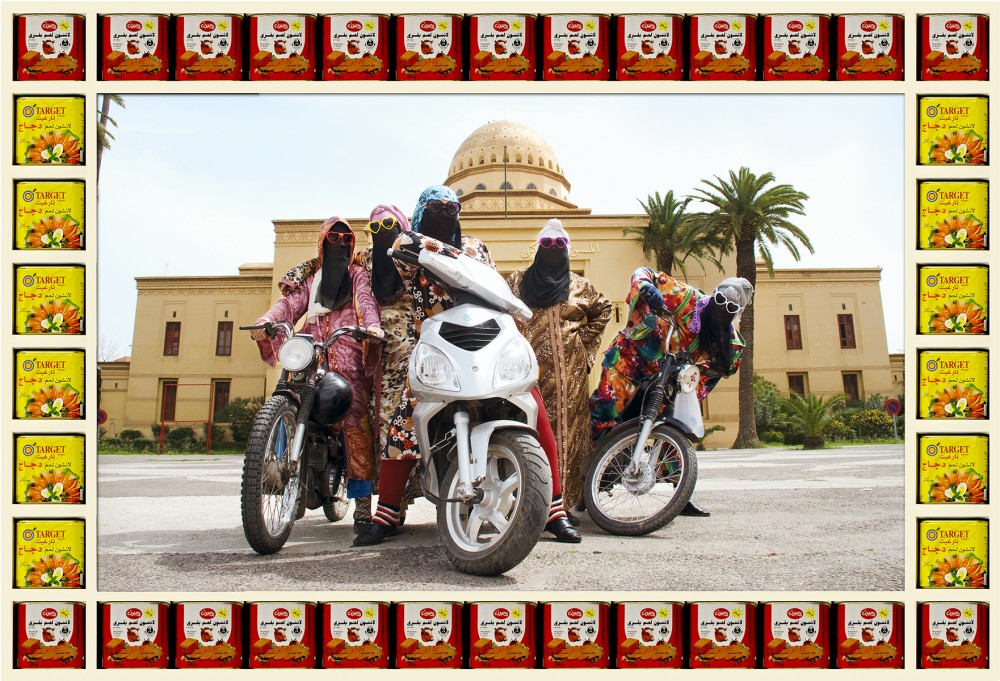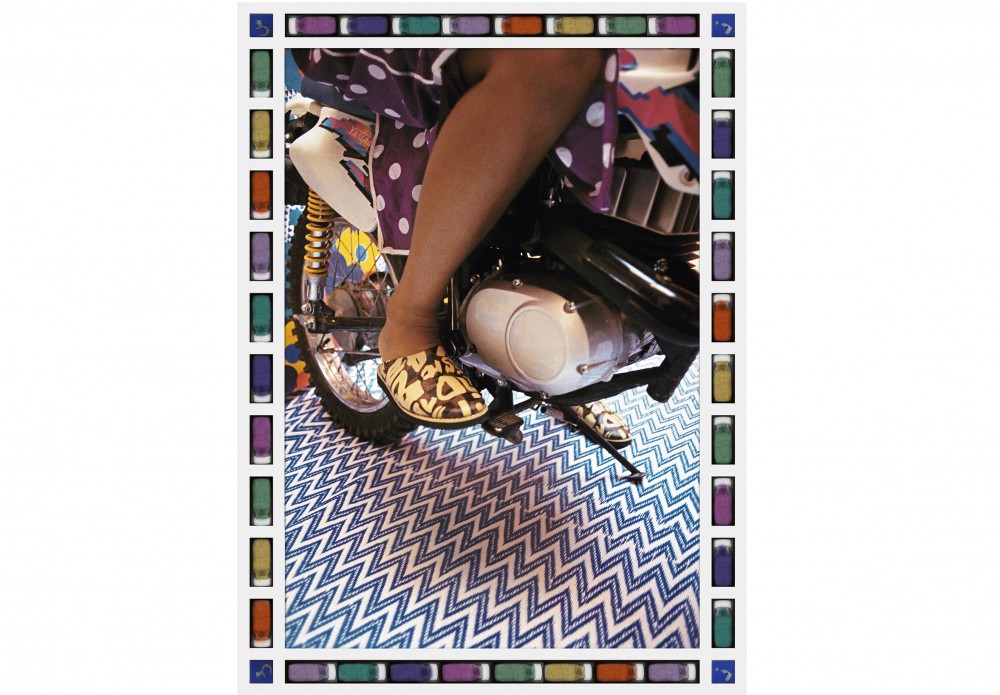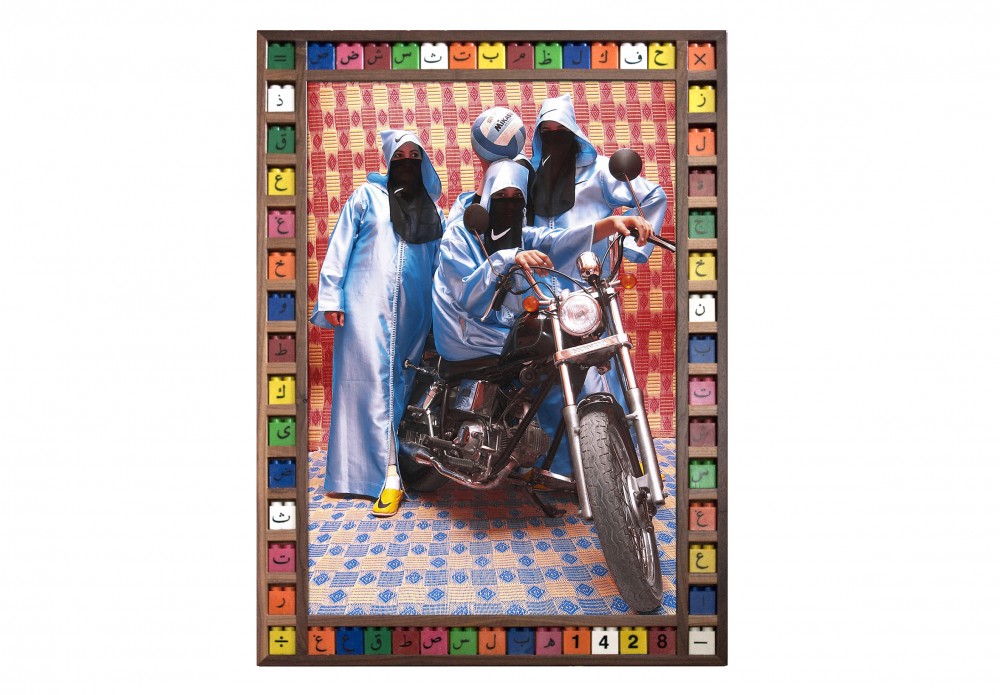Hassan Hajjaj’s photographs overflow with dualities, the result of a blending of Moroccan and British culture that has given him and his work a distinct, multicultural identity. As a transplant from Larache, Morocco to London, Hajjaj finds himself at the crossroads of East and West. These regional descriptors are rife with a set of implied contrasts, as if one’s place of origin rigidly defines one’s thoughts and actions in light of the rest of the world. Be wary of those who generalize the East in this way. This land, if it can even be categorized as one entity at all, stretches tens of thousands of miles and is home to hundreds of cultural groups and millions of individuals. It is a mistake to think that two wholly like minded individuals have ever been found among these endless multitudes. This is just a trick of the light.

Taymour Grahne Gallery’s Opening of Hassan Hajjaj: ‘Kesh Angels. January 28, 2014. Image credit: Photo by Scott Rudd
For Hajjaj, identity is not rooted in location. Particularity of place has been rendered irrelevant in our modern, globalized, post-colonial world. This does not mean, however, that the impact of colonialism is not still present in formerly-colonized nations or in Hajjaj’s photographs. Hajjaj’s images play into and subvert stereotypical notions of the Arab world, particularly of Arab women. They take the traditional, Orientalizing gaze of the Western artistic canon and turn it against itself, creating images that gaze back with a reclaimed sense of power and identity; the epitome of the globalized, post-colonial point of view. What Hajjaj presents us with is not dichotomy, but synthesis. Hajjaj’s influences stretch from fashion photography and advertizing to hip-hop style and North African culture. Most significantly, his works emphasize the amalgamation of the cultures of the colonizers and the colonized within a system of institutional inequality, one that in many ways continues to exist more subtly even after the colonial era. In this way, Hajjaj’s photographs, truly his artistic vision as a whole, represent the breakdown of colonialism and the reclamation of both indigenous and non-native culture under the influence of consumerism. Each of his photographs is a conversation across cultures, a mix of Warhol-esque pop expressionism and repetitive Islamic geometry. Within each image is an equal emphasis on both traditional North African street culture and Western consumer culture. The subjects of his photographs wear his original designs, veils and djellabahs in polka dots or adorned with Nike swooshes and Louis Vuitton logos. The photographs are often framed with cans of soda, tomato paste, and other product packaging; the modern world is encircled by products to be bought and sold, transported and translated. The Coca-Cola cans that frame Hajjaj’s photographs are symbols not only of consumerism in general but of American cultural colonialism and its inherent exploitation of the non-Western world that contributes to a global system of inequality. The British and Moroccan elements that inspire his artistic vision are little more than an endless stream of American cultural values wrapped up in a shiny package and served with a smile. The images Hajjaj produces show an awareness of these exploitative, Americanizing forces at play. The logos and imagery he has chosen is no accident. Nike, an American company known for the poor working conditions in its third world factories, features prominently in some of his most well-known photographs. He has brought inequality to the forefront and repackaged it in a transformative way. His photographs communicate the enticing temptation of American pop culture as well as the unique enticements of Moroccan culture. Only through the understood, semi-colonialist conventions of American consumer culture can one grasp the significance of Hajjaj’s own empowered rhetoric.

Hassan Hajjaj. Kick Start, 2006.
Despite the sometimes overwhelming presence of recognizable brands, commodities, and stereotypical imagery, Hajjaj’s subjects never lose their sense of agency and singularity. The stress Hajjaj puts on the collective world punctuates the individuality of his subjects. This proves especially true of his female subjects. They are shown as strong and independent, a stark contrast to the traditional stereotype of an Arab, Muslim woman as neither seen nor heard. He is working in the same vein as fellow photographers Shirin Neshat and Newsha Tavakolian to show a complex, multifaceted Muslim woman. Kesh Angels, the title image of his latest series of Moroccan women posing on motorcycles, shows women in brightly colored dress and heart-shaped sunglasses confidently posing on motorcycles. Not only is their confidence shown as an extension of their identity, this strong, female identity is presented as inseparable from their Arab, Muslim identity. These women defy nothing and everything in a single image. This synthesis of cultures expressed in Hajjaj’s photographs is possible only within the post-colonial world. His work is a product of his ties to both Morocco and Britain, yet it speaks of a truth present in neither locale. The diasporic voice is not a aggregation of multiple voices, but a new voice entirely. Like each aspect of Hajjaj’s photographs, this identity is completely hand-crafted. Though they are produced using familiar elements, each photographic iteration is a unique document of a global experience.
Text by Nora Landes

Hassan Hajjaj. Nikee Rider, 2007

